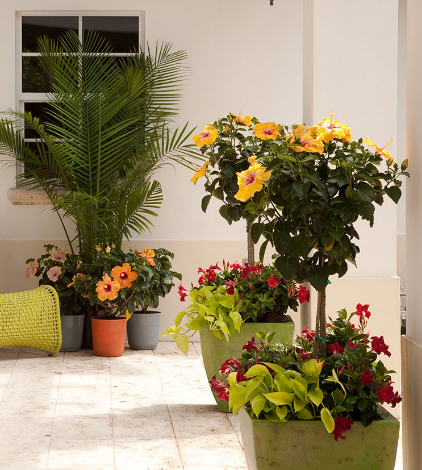
Spring: Snapdragon
Snapdragons are a natural pick for spring gardens and containers because they’re quick to grow and bloom -- and they don’t mind cool temperatures. These stunners come in a wide variety of colors, from rich reds to oranges to cheery yellows, to soft pink, and pure white. You also have some choices in shape: There are tall, upright varieties; low, mounding varieties; and even trailing varieties that spill over the sides of hanging baskets and containers. Bonus: Many varieties are fragrant!
Spring: Dianthus
Charming, easy-care, and delightful, dianthus are classics enjoyed by generations of gardeners. Most varieties are enjoyed as much for their beauty as they are for their spicy fragrances. Dianthus varieties typically bloom in shades of red, pink, and white, but look around and you can add shades of apricot, coral, and purple, as well as bicolors.
Spring: Osteospermum
Also called African daisy, this cool-season annual bears cheery flowers in a wide range of colors, from white and cream to yellow and orange to lavender and pink. Like many plants in the daisy family, it’s also a great pick for early-season bees and other pollinators. Unlike some cool-season flowers, osteospermum doesn’t fade when hot summer comes; it just stops blooming so you can still enjoy its attractive foliage. Gardeners in cooler-summer areas can enjoy its blooms all season long.
Spring: Viola
Spring flowers don’t get much more adorable than annual violas. These petite charmers offer fun blooms in practically every color of the rainbow, from pure white to rich and velvety purple-black. Their small size makes them perfect to use just about everywhere, too -- such as along walkways as a border plant, in small container gardens by themselves, in larger containers as accents mixed with other plants, or planted en masse for a big show of color as a statement in your landscape. 
Spring: Sweet Alyssum
One of the spring’s most fragrant flowers, sweet alyssum is invaluable for the texture it brings garden beds, borders, and containers. A low-growing variety, it has so many white, purple, or pink flowers that it’s like a carpet of color. It is breathtaking in hanging baskets, but also effective as an annual groundcover. Newer varieties hold up to heat and continue to bloom longer than older varieties.
Summer: Angelonia
Practically a perfect flower for summer, angelonia holds up to heat and drought, and it’s deer and rabbit resistant. The upright spikes add a wonderful textural contrast to more traditional mounding flowers. Angelonia traditionally comes in shades of blue and purple, but look around and you can also get varieties that bloom in pink, rose, and white.
Summer: Vinca
Like angelonia, annual vinca is practically indestructible all summer long (as long as it doesn’t stay too wet) and is ignored by hungry deer and rabbits. It loves heat and humidity, doing as well in a Minnesota summer as a Miami one. It offers a wide range of flower colors, as well as a mix of plant shapes, including low and spreading, as well as mounded and upright.
Summer: Lantana
Lantana is like a summer party in the garden. The flowers appear in ball-like clusters, and individual blooms change color as they age, creating a multicolor look. Watch for selections with flowers in shades of red, orange, yellow, peach, pink, purple, and white. It’s also a top pick if you’re looking to bring butterflies and hummingbirds to your yard.
Summer: Zinnia
One of the best cut flowers around, zinnias offer nonstop blooms throughout the summer in an incredibly wide range of flower colors, sizes, and shapes. Single-flowered varieties tend to last the longest and look like daisies; double-flowered types are more lush and opulent, being full of petals. Older varieties often suffer from disease in humid-summer areas, but newer selections hold up to all types of summer weather.
Fall: Celosia
Perfect for fall gardens and containers thanks to their feather-like blooms in shades of red, orange, yellow, as well as pinks and purples, celosia is an old-school flower that’s still popular today. It holds up well to a wide variety of weather conditions and adds much-needed texture to garden beds and borders. It looks fabulous with mums!
Fall: Pansy
A classic in spring or fall, pansies offer festive blooms in a wide range of colors. Shades of red, orange, yellow, and nearly black are especially popular in autumn, but if you’re looking to contrast the traditional seasonal shades, you can also get them in soft shades of pink, purple, blue, and white. In mild-winter areas, you can enjoy the show from pansies all winter long. In colder areas, the plants go dormant over winter, then rebloom the following spring.
Fall: Sedge
Ornamental grasses are always popular in fall for their texture, and sedges are, too. Some of the most common varieties of these grass-like plants for fall have bronzy foliage. It can create a love-it-or-hate-it effect (some folks say the neutral color is a fun contrast, but others think the plants look dead), but sedges are easy to grow and look good with other fall flowers.
Fall: Ornamental Pepper
Like celosia, ornamental peppers usually bring in traditional fall colors to garden beds, borders, and container gardens. Unlike the other plants on our list, the interest comes from their fruits rather than flowers. Many varieties have multi-color fruits, that start out green, then go yellow, and finally turn red at maturity.
Fall: Flowering Kale
While it’s not a tasty treat (like its relative, regular kale, a trendy superfood), flowering kale is a feast for the eyes with its ruffled gray-green leaves that change to shades of red, pink, purple, and white at the center. A cool-weather lover, it can hold up all winter long in mild areas and continues to look good, even after a light freeze or two.

















